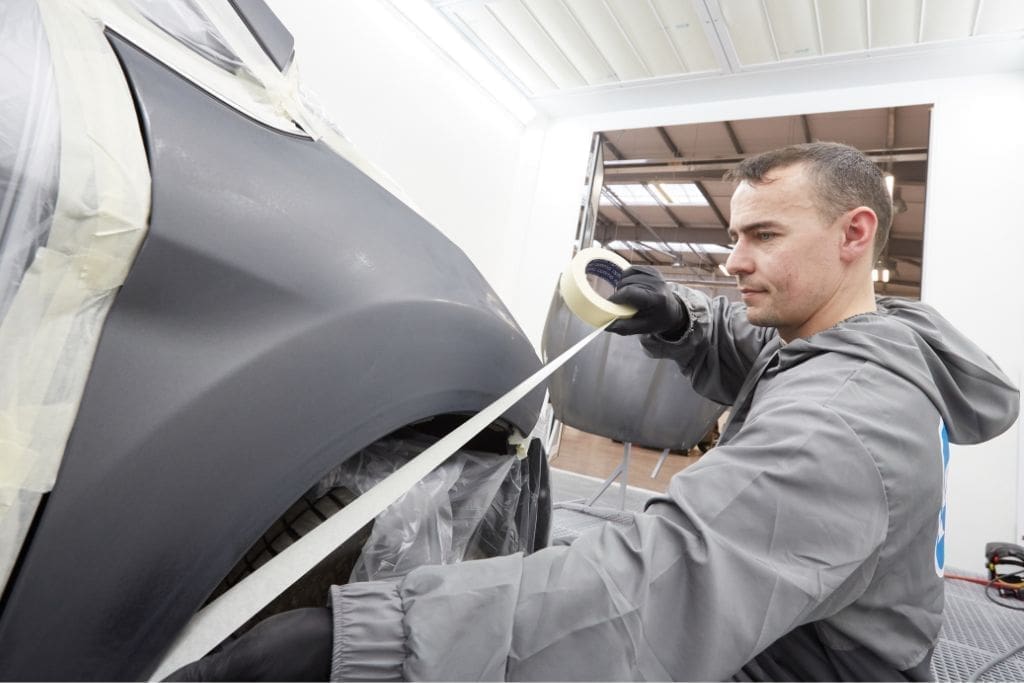Repairers are increasing their use of ‘green parts’ as an alternative to brand-new components in vehicle repair.
They’re a tried and tested solution used by insurers to conduct more sustainable, cost-effective repairs to their customers’ vehicles.
If you’ve been offered a green part repair, you may wonder why this is the case, and whether they offer the same quality/safety standards as new OE parts.
Here we discuss why green parts are used in vehicle repair, and how their quality compares with off-the-shelf components…
What are ‘Green Parts’
‘Green Parts’ are second-hand OE (Original Equipment) parts which have been recovered from vehicles at the end of their useful lives.
Many of these vehicles have been deemed ‘total loss’ by insurance companies, meaning the expense of repairing the vehicle outweighs the cost of its replacement.
Most ‘total loss’ vehicles will actually have many intact, undamaged parts which can be salvaged and reused by repairers – at a fraction of the cost of new components.
“Green parts are a great sustainable alternative to new parts, while providing the same safety and quality as brand-new components.
They can even be quicker to source than new parts, making them an effective way to speed up repair turnaround for customers – getting their car back on the road quicker.” – Mark Hobson, Operations Manager, Activate Parts
Why have I been offered a green part for my vehicle’s repair?

Your repairer may choose to offer a ‘green part’ repair for a number of reasons, including your insurer’s own repair policies. Here’s why you may have been offered a green part, rather than a brand-new component, for your vehicle’s repair…
They can be quicker to source than brand-new components
Green parts are often quicker to source than new OE components. This means repairers are able to conduct repairs more quickly, without having to rely on new parts manufacturing or international supply chains.
The motor repair industry is currently grappling with worldwide supply chain issues, which are leading to delays in the time it takes to source brand-new parts. Green parts help to mitigate this challenge, getting customers back on the road sooner.
They’re more environmentally sustainable
Using green parts drastically reduces the number of used components sent to landfill, as well as tackling the carbon footprint associated with manufacturing/shipping new parts.
This makes them a powerful resource for insurers/repairers seeking to increase the environmental sustainability of their repair strategies.
They cost less at-purchase than new parts
Buying used parts can provide an at-purchase discount of up to 50%, helping to reduce the costs associated with vehicle repair.
This helps to bring down the average cost of insurance claims, which can be passed onto repair customers in the form of lower insurance premiums/excess payments.
While this doesn’t account for the additional costs often needed to respray green parts, it still provides a powerful way for insurers to control overall repair costs.
They’re part of your insurer’s repair policy
Insurers sometimes set a preference for green part repairs in their wider repair policy, meaning they’ll always use one if it’s an option.
This may be due to their sustainability targets as an organisation, or to support cost-saving initiatives within their claims strategy.
Can I turn down a used vehicle part if it’s offered to me?
Your ability to choose between new/second-hand parts depends heavily on your insurers’ repair policy.
In non-fault incidents, where you’re dealing with a third-party’s insurer, it may be possible to request a brand-new part over a green part. However, in at-fault claims, your insurer may require you to accept a green part as a cost-mitigation measure.
If you’re unsure about your insurers’ policies around green/second-hand parts, it’s best to consult them to understand your obligations.
Are there any risks associated with using green vehicle parts?
As long as they go through the proper checks, green parts can be just as safe as their off-the-shelf counterparts.
At Activate Accident Repair, safety is always our number one priority when it comes to utilising second-hand components. Here are some of the steps we take to ensure the safety and integrity of green parts:
Safety & quality checks
Green parts undergo comprehensive checks to ensure they’re safe to use on your vehicle. This includes ensuring there’s no damage to the part in question, and that it’s fully compatible with the vehicle.
Repairers won’t use green parts which have been directly affected in an incident. They will often check with the supplier to make sure the part hasn’t come from an area of the vehicle that has sustained damage – using photographic evidence to support this.
Cosmetic vs safety-critical repairs
Repairers won’t use green parts for repairs which directly impact the safety of your vehicle. They’re mainly used for cosmetic repairs, such as replacing doors, bumpers, or wing mirrors.
This means a green part won’t normally be offered to replace mechanical components, or any part which could impact the roadworthiness of your vehicle.
Prioritising OE parts
When using green parts, repairers will usually opt for second-hand OE components – rather than aftermarket. This means the parts they use are fully compatible with your vehicle, and meet the safety/quality standards originally set by the manufacturer.
Cosmetic OE parts are designed to last the lifetime of your vehicle. Since second-hand OE parts are only usually a few years old at the time of their recovery, they still provide the same longevity you’d expect from brand-new components.
In Summary
Repairers are increasing their use of ‘green’ or second-hand parts in vehicle repair. If you’ve been offered a green part repair by your insurer, you may wonder why, and whether they provide the same quality/safety standards as brand-new components.
They may be offered for a number of reasons, including:
- Because they’re quicker to source than brand-new parts
- They’re more environmentally sustainable
- They cost less to purchase than brand-new parts
Green parts undergo comprehensive checks to ensure they’re safe to use, and provide the same compatibility & quality assurances as brand-new components.
Any second-hand parts used by vehicle repairers are usually OE (Original Equipment) – meaning they were designed and made by your vehicle’s manufacturer. This means they provide the same quality for a cheaper price.
They’re mainly used for cosmetic repairs, such as replacing doors, wing mirrors, or bumpers – meaning they pose very little risk to the roadworthiness of your vehicle.
Repairers won’t use a green part if it’s been damaged or modified in any way, meaning they’re usually in the same condition as off-the-shelf components.
To learn more about Activate Accident Repair’s use of green parts, download our free information flyer here:


Leave a Reply